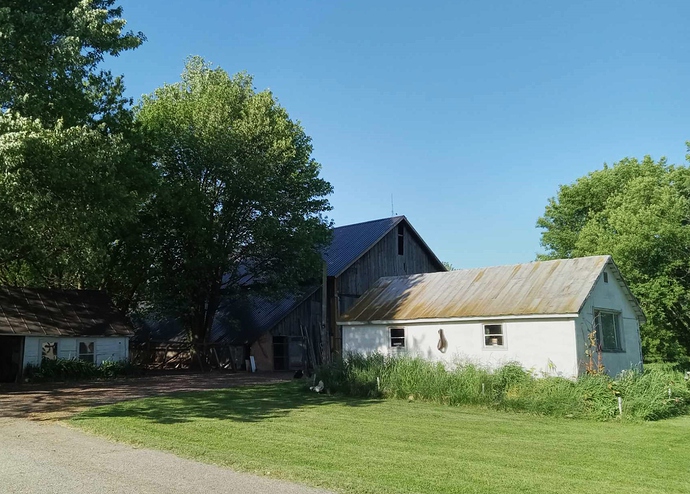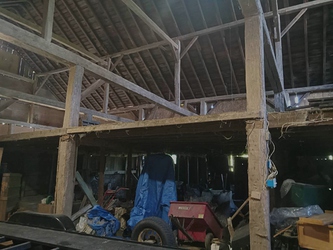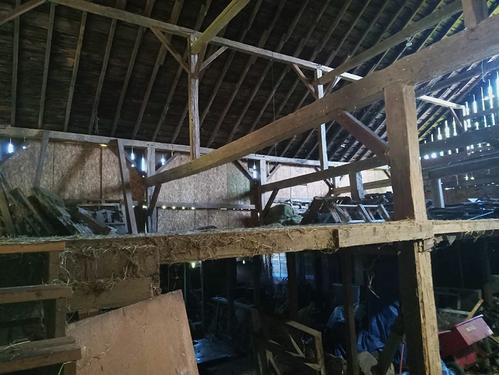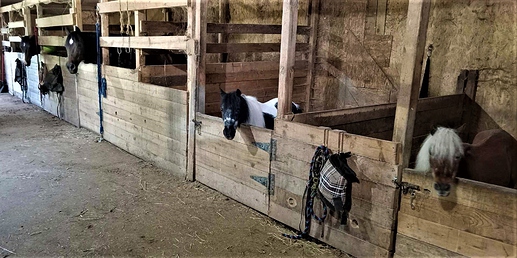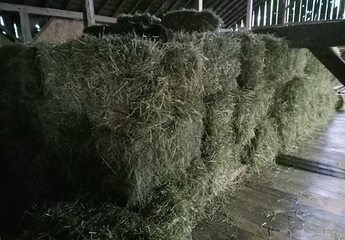Huh? An epsom salt poultice is a sweat.
This has been my experience too. I hate humid summers. And springs. And winters.
One reply for all the comments. First, hay moisture tested 2022 16.4%. Second, if I suspect any heavy bales, I put them aside and open them. Third, plenty of airflow - this is an 1800’s dairy barn, built right for storing hay. Hay does not get wet in my barn. Fourth, new roof completed 2022 - it did take us a few years as we did it ourselves. Will post butt-pucker pictures another thread. My husband is amazing! 
However, you all did make me rethink - I didn’t have any issues with the funk until I put a load of wet hay (which went back) in my barn. I also had the scary open the bales and steam came out. So that may have brought the funk in. And hindsight - we put the new roof on because the old one was starting to fail. While I kept the hay in the area that was dry, I’ll bet that the moisture from the other areas didn’t help. I am going to bleach the floors again just to see if that helps.
Picture of my 1800’s barn with its new roof - the siding is covered inside with plywood to keep the wood on so what is inside is mostly protected.
Then pictures of the hay loft - you can see it’s designed for 1,000 bales, and I only put up 400 (they are smaller squares). Plenty of airflow. Since it’s a wood barn it also breathes - my one neighbor when they had a horse had a aluminum pole barn and had funky hay issues because it was sealed so well. Excuse the mess - I am working 45 hours until next week, then spring cleanup and purging will occur!
All the way to the left is my stall area, which is also totally open. The first hayloft picture, the last beam is the end of the loft, then the horses have their stalls below but not underneath, in a separate open area.
Nothing big or fancy, I built the stalls myself. But you can see that airflow is not the issue, wet hay is not the issue, and it’s just the bottom bales (and not all of them). Just trying to figure out if there is a way to prevent it. If I open the bales with the funk (it’s not much of a funk, but I can smell it), the funk goes away in about an hour. Old barn odors maybe? It was built in the 1880s or so.
Not sure who said put plastic over wood, bales on top of that. I am going to say this won’t work to prevent molding. Wood will draw moisture from the ground, cement floor and plastic above won’t protect the bottom bales. Once the wood is wet, it stays wet, gets mold in it to create the mold/funky smell problem. I would not feed the smelly hay or moldy hay, it might work as garden mulch, but YOU do not want to be breathing mold or letting horses breathe it. Smell is your warning, this is BAD hay!
Plastic or rubber layer MUST be on the ground or cement floor with wood above to prevent hay molding.
On the salting of hay, it is an old method of preservation for emergency drying or lose the hay crop. Never heard of it for bales, just loose hay. Salt has always been a drying agent, a preservative for food stuff like fish and meat before there was refrigeration. Things they dried were cut into thin layers to have faster, thorough drying before meat could get rotten. Then meat products were smoked or stored wrapped in various waxed papers waxed cloth, to seal them up, perhaps put in barrels of salt, jars, until they were needed. Lots of sun or air movement over drying meats, fish, was usually part of the drying-preservation process. Once dried you didn’t leave the meat exposed to air to moisturize the salt again.
They sell moisture meters you can use on bales. Also long stem thermometers to see if a bale is “hot inside.” But as mentioned, moving bales into the stack will tell you which are heavier to set aside, check for moisture or feed first. Sometimes parts of the field don’t dry as fast as the rest of the field. Clover is lots slower to dry than grasses. We sprayed the clover dead, it added two DAYS more to us getting hay done. Just have grass fields now. And there is the spray-proprionic acid which dries high moisture hay when you can’t wait on the weather. My horses loved the sprayed hay, it kept all it’s nutrition. We actually fed less of it over winter. But again, the sprayed hay MUST be kept separated from regular hay. NO TOUCHING or it wicks the hay moisture out and molds. We hung a big plastic tarp from the roof trusses between the sprayed and unsprayed hay piles, had no mold issues. But those sprayed bales were HEAVY, kept every single calorie until they were fed. Ha ha
This was my immediate thought.
My question is, then, how do people with hay barns separate from their livestock barns, avoid wet/moldy/burning hay? There has to be a way.
No, it is not necessarily a sweat.
Above I believe I got my terminology confused, I think osmosis is the more correct term. If you care to look it up further, check out the science behind salt-cured meat. Salts draw stuff out of stuff (technical! 

 ), not just out of air, and not necessarily with added (or captured) heat.
), not just out of air, and not necessarily with added (or captured) heat.
There’s a huge difference between moldy bottoms and burning hay.
Hay that is moldy/hot on the inside of the bale is not for storage. Occasionally my hay supplier has had a field get wet after cutting and has sold/given those bales only to people who will feed it immediately. It will be bad if stored, or potentially dangerous. I agree that there is no way a layer of salt between bales will make up for improperly baled hay. Maybe it could help hay that got rained on after baling, but even that seems like more of an old wives tale than anything.
In a perfect barn/loft, good bales might not get moldy on the bottom if stored, but I think most people have to deal with it to some extent. I don’t have a loft; I have to be careful with ground storage – I have gravel with pallets, then plywood, then pallets. LOL. It’s like the princess and the pea. But I also got lucky to find a supplier that would sell me only 100 or so at a time, so I don’t have to store it for the whole season. That’s the best solution for me.
A bale that would spontaneously combust would be noticeably heavier, damp and green and unless a supplier stacked the hay and you weren’t able to check the bales before they did, I don’t see how anyone would include those bales in the loft or any stacked bales.
They are impossible to miss but if you have hay delivered and stacked I can see that happening. You are at the mercy of someones honesty/ integrity and that can be lacking.
We have always made it a practice to put any heavy bale, a bale with a green plug or a damp feel immediately aside, opened up and let it air out. It takes only a few days in hot , humid temps for them to be insanely hot if left unopened and not spread out. Many times it will still get dusty and be composted.
You were fortunate.
I thought of this thread today.
Nothing to do with hay, but salt.
It is humid here this morning.
In two stalls, with a salt block in a holder on the wall, there is water dripping down the wall from the salt block.
In the one stall that does not have a salt block there anymore, but there used to be a holder with a block, there is still enough salt on the wall that the wall is wet and dripping.
This makes me feel like putting salt in my hay would lead to more water there, not less.
Look up something where salt is used to dry, like meat/fish curing.
But it’s a totally different method of action.
When you cure meat, you completely coat it in salt. That creates a concentration gradient; some salt dissolves into the moisture in the meat and water will move outward to evaporate. Also, the salt inhibits a lot of microbial growth.
But that’s not the same as what happens when a salt block or table salt shaker attract moisture. Salt is also hygroscopic and attracts moisture from the air.
Salting hay is going to be more similar to the second situation than the first. A hay bale is not an aqueous medium like meat. You can’t “coat” the hay in the same manner as you would meat to get a concentration gradient. Not only is the amount of hay prohibitive, but horses likely wouldn’t eat it.
In a dry, low humidity environment with good airflow, salt between bales or under bales probably won’t make much difference. But it it’s humid, you’re just inviting more moisture in.
But it’s a totally different method of action.
When you cure meat, you completely coat it in salt. That creates a concentration gradient; some salt dissolves into the moisture in the meat and water will move outward to evaporate. Also, the salt inhibits a lot of microbial growth.
Yes - but I am also sure that unless done in the right conditions, it could still become a rotting, moldy mess. I doubt it would be as easy to salt fish in a humid or tropical environment versus a cooler, less humid one.
ETA - still don’t understand how salting hay would help. Even in the meat example, it must be tricky. But I agree with you - don’t see how salt helps keep moisture from hay, and I don’t believe that you can use salt between bales to effectively dry the inside of a damp bale.
Before I had my own place and I was doing full care with another person and we were renting the barn/pasture - we had a hay loft in the barn. Now, I am in the humidity capital of the world (outside of Florida) and we NEVER had a problem with hay stored in the loft, even the bottom bales.
Nowdays I do not have a hay loft, store at ground level and I cannot seem to keep bottom bales stored at ground level non-musty if I keep them over a few months time. Maybe in the winter I am OK. I have plastic on the floor and plastic pallets that do not hold moisture (like wood pallets) on top of that. So I keep some old bales for a year or two (or three) and use that as my bottom layer. That seems to work. I was really surprised that the hay I had stacked on my flatbed trailer during the summer had musty bales on the bottom layer. I have never had that problem before.
My only solution is to not have a “Good” hay layer on the bottom and not to keep hay much longer than half a year. Which sucks because I am getting really nice first cutting OG hay at prices below last year and I would love to get a years worth of hay now. But it won’t last 12 months and I am not going to try to salt stuff to make that work. Because it won’t.
the hay I had stacked on my flatbed trailer during the summer had musty bales on the bottom layer
Yeah, this didn’t work for me either, the one time I decided to buy an extra load of beautiful hay, thinking I could store it on the flatbed (planned on feeding it first). What a waste! Never tried doing so again.
I’ve never been able to store an entire year’s worth of hay for my horses – I’d have loved to not pay the feed store hay price when waiting for second cutting – but perhaps I need to quit regretting that I haven’t the space.
I can’t store any appreciable amount of hay in the summer without it getting surface mold. It’s just soooo hot and humid here (Delmarva).
I don’t know if a loft would be better. Clearly there are hay growers around here who store their hay somehow. Most of the horse farm owners I know are only storing a couple months worth of hay at a time and not filling their barns for the year. When I buy hay for the winter, I wait until fall so I don’t have to deal with mold. (Not happening these days, not enough storage.)
I posted on another thread, but I have all my hay in! You can see how open/airy the loft is, and the spacing I can do between bales. This is 400 bales for reference.
Hopefully this year no funk!!!
My hayloft has a wooden floor, and I have never (20+ years here) had a problem with wet or moldy hay. At one point I had hay that had been stored for 3 years with no problems.
At stall level, my hay stall has a concrete floor (like the rest of he barn) covered by a layer of full shavings bags, and I stack the “current” hay there- usually less thn 10 bales. I hav never had any mold problems there either. I am in VA, and it gets pretty humid.
My hayloft has a wooden floor, and I have never (20+ years here) had a problem with wet or moldy hay. At one point I had hay that had been stored for 3 years with no problems.
I wonder if the type of wood and/or if treatment (or lack thereof) makes a difference.
Perhaps people need to consider or improve air flow in lofts or floor level storage locations. There was always air moving in Grampa’s loft. Walls had openings between vertical outside boards. There was a hay loft door that opened under the roof peak, to increase air flow.
We have a pole barn, both end doors are open most of summer, daily for a time during winter. Three air vents in the roof line. The prevailing SW wind blows thru most of the time to continue drying stored bales. A big fan on the SW end would add even more air flow if needed.
Michigan gets very humid in the summer months, yet most stored hay does not get moldy when put up dry. I now have a moisture meter to stab into bales, checking moisture levels. Usually they are VERY low moisture since husband is careful when deciding to bale or wait longer. We now put up our own hay, usually over 1000 bales of first cutting grass for 7 to 9 horses. Some years we get a second cutting, with bale quantity depending on how much summer rain we got. But air movement over bales is what prevents molding on good, dry wood surface flooring, along with sorting out the heavy bales that probably are damp, when hay is put in the barns. We have fed the heavy bales if just a few or sold them cheap to a friend with roping cattle. Friend was glad to get them and fed damp bales quickly. We were glad to get those bales gone!

